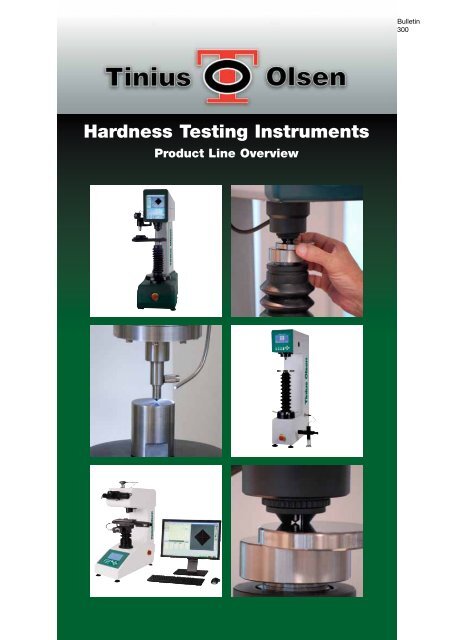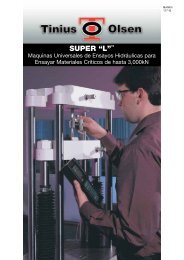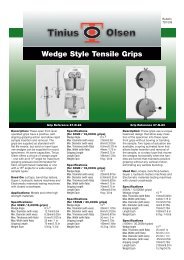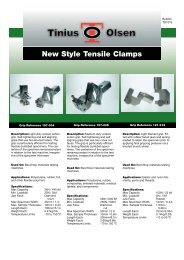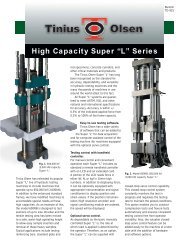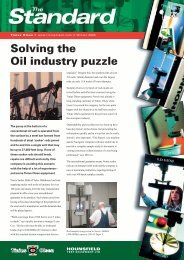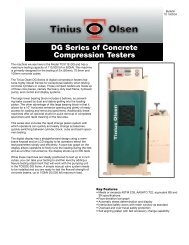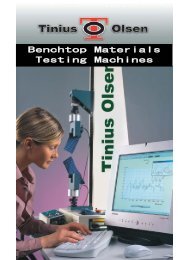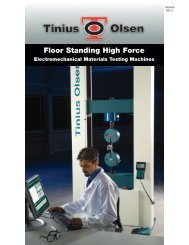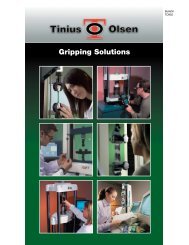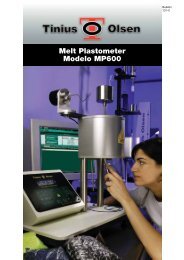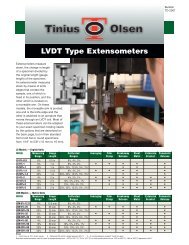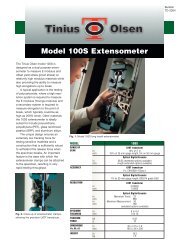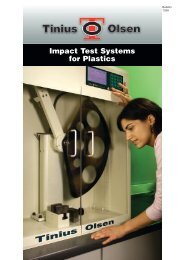Bulletin 300 Hardness Testing Instruments Product - Tinius Olsen
Bulletin 300 Hardness Testing Instruments Product - Tinius Olsen
Bulletin 300 Hardness Testing Instruments Product - Tinius Olsen
Create successful ePaper yourself
Turn your PDF publications into a flip-book with our unique Google optimized e-Paper software.
<strong>Hardness</strong> <strong>Testing</strong> <strong>Instruments</strong><br />
<strong>Product</strong> Line Overview<br />
<strong>Bulletin</strong><br />
<strong>300</strong>
2<br />
HARDNESS TESTER SERIES OVERVIEW<br />
Basic, load<br />
cell based<br />
Rockwell<br />
tester<br />
FH30 Series FH1 Series FH2 Series FH3 Series FH10 Series FH11 Series<br />
Rockwell <strong>Hardness</strong> Testers<br />
FH1 Series FH2 Series FH4 Series<br />
Vickers <strong>Hardness</strong> Testers<br />
FH1 Series FH2 Series FH3 Series FH9 Series FH10 Series<br />
Brinell <strong>Hardness</strong> Testers<br />
Universal <strong>Hardness</strong> Testers<br />
FH5 Series FH9 Series FH10 Series<br />
FH1 Series FH2 Series FH10 Series FH11 Series FH12 Series<br />
FH11 Series<br />
FH12 Series<br />
FH11 Series<br />
FH12 Series<br />
FH12 Series
HARDNESS<br />
<strong>Hardness</strong> is the property of a<br />
material enabling it to resist plastic<br />
deformation, usually by penetration of<br />
another object. The term “hardness”<br />
may also refer to stiffness, temper,<br />
or resistance to bending, scratching,<br />
abrasion, or cutting.<br />
Scientists and journalists often<br />
confuse stiffness with hardness and<br />
is demonstrated by, for example, the<br />
element Osmium, which is stiffer than<br />
diamond, but not as hard as diamond.<br />
In materials science there are three<br />
principal operational definitions of<br />
hardness:<br />
• Scratch hardness: Resistance to<br />
fracture or plastic (permanent)<br />
deformation due to friction from a<br />
sharp object<br />
• Indentation hardness: Resistance<br />
to plastic (permanent) deformation<br />
due to a constant load from a sharp<br />
object<br />
• Rebound hardness: Height or speed<br />
of the bounce of an object dropped<br />
on the material, related to elasticity.<br />
Measuring <strong>Hardness</strong><br />
<strong>Hardness</strong> is not an intrinsic material<br />
property. There are no precise<br />
definitions in terms of fundamental<br />
units of mass, length and time. A<br />
hardness property value is the result of<br />
a defined measurement procedure.<br />
<strong>Hardness</strong> of materials has long<br />
been assessed by resistance to<br />
scratching or cutting. An example<br />
would be material B scratches material<br />
C, but not material A. Alternatively,<br />
material A scratches material B slightly<br />
and scratches material C heavily.<br />
The usual method to obtain a<br />
hardness value is to measure the<br />
depth or area of an indentation left by<br />
an indentor of a specific shape, with<br />
a specific force applied for a specific<br />
time. There are several principal<br />
standard test methods to express the<br />
relationship between hardness and the<br />
size of the impression or the rebound<br />
velocity on specific materials. Vickers,<br />
Rockwell, Brinell and Leeb are the<br />
most common scales. For practical<br />
and calibration reasons, each of these<br />
methods is divided into a range of<br />
scales, defined by a combination of<br />
applied load and indentor geometry or<br />
in case of the rebound method, by the<br />
weight of the impact body.<br />
Most Common <strong>Hardness</strong> Tests<br />
Rockwell (HR scales)<br />
Indenting the test material with a<br />
diamond cone (HRC) or hardened<br />
(tungsten) steel ball indentor (HRB etc.)<br />
applying a preload of 10 kgf first and<br />
a main test force of 60, 100, or 150 kgf.<br />
Rockwell Superficial (HR scales)<br />
Indenting the test material with a<br />
diamond cone or hardened (tungsten)<br />
steel ball indentor, depending on the<br />
scale preliminary set. The Superficial<br />
Rockwell scales use lower force and<br />
shallower impressions on brittle and<br />
very thin materials. Applying a preload<br />
of 3 kgf first and a main test force of<br />
15, 30, or 45 kgf.<br />
Vickers (HV)<br />
Indenting the test material with a<br />
diamond indentor, in the form of an<br />
upside down perfect pyramid with<br />
a square base and an angle of 136<br />
degrees between opposite faces,<br />
subjected to test forces of 1 to 120<br />
kgf. A microscope or USB camera<br />
is used to visualize and measure the<br />
indentation.<br />
Micro-Vickers (HV)<br />
Indenting the test material with a<br />
diamond indentor, in the form of an<br />
upside down perfect pyramid with<br />
a square base and an angle of 136<br />
degrees between opposite faces,<br />
subjected to test forces usually not<br />
exceeding 1 kgf. A precision microscope<br />
or high resolution USB camera<br />
is used to visualize and measure the<br />
indentations, magnifications up to<br />
600x are most common. However,<br />
magnifications up to 1000x are<br />
becoming popular as well.<br />
Knoop (HK)<br />
Indenting the test material with<br />
a “elongated” diamond pyramid,<br />
sub jected to test forces usually not<br />
exceeding 1 kgf. A precision microscope<br />
or high resolution USB camera<br />
is used to visualize and measure the<br />
indentations, magnifications up to<br />
600x are most common.<br />
Brinell (HB)<br />
Indenting the to be tested material<br />
with a 1, 2.5, 5, or 10 mm diameter<br />
hardened steel or carbide ball<br />
subjected to a load/force ranging<br />
from 1 to <strong>300</strong>0 kg. A microscope or<br />
USB camera is used to visualize and<br />
measure the rather large indentations.<br />
Leeb (HL) (rebound method)<br />
Portable hardness testing. An impact<br />
body that has a spherical tungsten<br />
carbide tip, is impelled onto the<br />
test surface by spring force. The<br />
impact creates a plastic deformation<br />
of the surface, an indentation,<br />
due to which the impact body<br />
loses part of its original speed (or<br />
energy). Consequently, the softer<br />
the material is, the more speed will<br />
be lost at rebound of the impact<br />
body. Applicable for a wide variety<br />
of components. Minimum test<br />
requirements should be obeyed.<br />
Ultrasonic (UCI)<br />
Portable hardness testing. A Vickers<br />
shaped diamond indentor fixed on a<br />
vibrating rod that presses on the test<br />
surface with a specific force and then<br />
measures its hardness by applying<br />
ultrasonic vibrations and analyzing its<br />
damping effect. Commonly used for<br />
small, thin components that cannot be<br />
tested by rebound hardness testers.<br />
Shore (HS scales)<br />
Portable (rubber/plastics) hardness<br />
testing. The hardness value is<br />
determined by pressing the indentor<br />
foot firmly onto the sample. The<br />
indentor is connected to a linear<br />
measuring device and measures<br />
the indent depth, which is then<br />
converted through a mechanical or an<br />
electronical system to the Shore value.<br />
The deeper the indent, the softer the<br />
material.<br />
IRHD<br />
Measures the indentation resistance<br />
of elastomeric or rubber materials<br />
based on the depth of penetration<br />
of a ball indentor. An initial contact<br />
force is applied to a 1, 2.5, or 5 mm<br />
ball indentor and the penetration is<br />
set to zero. The force is increased to<br />
a specified total load and the depth<br />
of the penetration is measured. The<br />
IRHD value is related to the depth of<br />
indentor penetration. The method is<br />
commonly used for testing small parts<br />
and Orings.<br />
Webster<br />
Portable hardness testing. The object<br />
to be tested is placed between the<br />
anvil and the penetrator. Pressure<br />
is then applied to the handles until<br />
“bottom” is felt, at which time the dial<br />
indicator is read. There are different<br />
types of indentors and different force<br />
settings for different materials.<br />
Less Common <strong>Hardness</strong><br />
Scales<br />
The following hardness methods are<br />
less frequently used or superseded by<br />
other methods:<br />
• HM – Martens (formerly HU –<br />
universal hardness)<br />
• H – ball indentation hardness<br />
• HVT – modified Vickers method,<br />
depth measurement<br />
• HBT – modified Brinell method,<br />
depth measurement<br />
3
4<br />
FH-1 SERIES<br />
ROCKWELL AND UNIVERSAL HARDNESS TESTERS<br />
MODEL FH-1-0<br />
Rockwell<br />
• Load cell based, closed loop<br />
operation<br />
• Advanced user interface<br />
• Scales:<br />
Basic Rockwell<br />
• Automatic testing procedure<br />
• Conversion to all other hardness<br />
scales<br />
• Convex and concave testmodus<br />
• Database for test programs<br />
• Large workpiece accommodation<br />
• On-line statistics<br />
• USB output<br />
MODEL FH-1-1<br />
Rockwell and Superficial Rockwell<br />
• Scales:<br />
Rockwell: A, B, C, D, E, F, G, H, K,<br />
L, M, P, R, S, V<br />
Superficial Rockwell: 15N, 30N,<br />
45N, 15T, 30T, 45T, 15W, 30W,<br />
45W, 15X, 30X, 45X, 15Y, 30Y, 45Y<br />
MODEL FH-1-2<br />
Rockwell, Superficial Rockwell,<br />
and Brinell<br />
Same features as FH11, but with<br />
additional Brinell scales<br />
• Additional Scales:<br />
Brinell: HB1/1, 2.5, 5, 10, 30 kgf;<br />
HB2.5/6.25, 15.625,<br />
31.25, 62.5, 87.5 kgf; HB5/ 25,<br />
62.5, 125, 250 kgf;<br />
HB10/ 100, 250 kgf<br />
• Brinell microscope with LED<br />
ring light<br />
Optional Accessories<br />
for FH-1 Series<br />
• Certified hardness test block<br />
±450HV (FH13)<br />
• Certified hardness test block<br />
±200HB (FH12/ FH13)<br />
• Certified hardness test block<br />
±60HRC<br />
• Certified hardness test block<br />
±30HRC<br />
• Certified hardness test block<br />
±85HRB<br />
• Motorised elevator spindle<br />
• Rockwell diamond cone 120°<br />
• Vickers diamond cone 136°<br />
(FH13)<br />
• Rockwell ball indentor 1.6 mm<br />
(1/16")<br />
• Brinell balls indentors 1 mm,<br />
2.5 mm, 5 mm, 10 mm (.04, .10,<br />
.20, .39") (FH12/FH13)<br />
• V-Anvil 60 mm (2.36")<br />
• Long indentors<br />
• Goose neck indentor holder<br />
• Large testing table <strong>300</strong> x 200 mm<br />
(11.81 x 7.87") with Tslot<br />
• Custom testing tables<br />
• Precision vices, V-blocks, and<br />
special clamps<br />
Fig 1. Model FH11<br />
MODEL FH-1-3<br />
Rockwell, Superficial Rockwell,<br />
Brinell, Vickers, HBT, and HVT<br />
Same features as FH12, but with<br />
additional Vickers scales<br />
• Scales:<br />
Brinell: HBT2.5/62.5, 187.5 kgf;<br />
HBT5/250 kgf; Vickers: HV 1, 2, 3,<br />
5, 10, 20, 30, 50, 100, 120; HVT 50,<br />
100 kgf<br />
• Built-on electronic digital<br />
microscope for Brinell and Vickers<br />
indent measurement<br />
• Objectives 2.5x, 5x, 10x<br />
magnification<br />
• Adjustable LED illumination<br />
• LED Ringlight (optional)<br />
• Precision workpiece sliding table<br />
• Large workpiece accommodation Fig 2. Model FH13<br />
Fig 2A. Model FH13 from Side
FH-2 SERIES<br />
ROCKWELL AND UNIVERSAL HARDNESS TESTERS<br />
MODEL FH-2-0<br />
Rockwell, Superficial Rockwell,<br />
HBT, HVT, and H ball indentation<br />
• Full color multi function touch<br />
screen controller<br />
• Load cell based, closed loop<br />
operation<br />
• Advanced user interface<br />
• Scales:<br />
Rockwell - A, B, C, D, E, F, G, H, K,<br />
L, M, P, R, S, V,<br />
Superficial Rockwell -15N, 30N,<br />
45N, 15T, 30T, 45T, 15W,<br />
30W, 45W, 15X, 30X, 45X, 15Y,<br />
30Y, 45Y;<br />
Brinell HBT2.5/62.5, 187.5 kgf;<br />
HBT5/250 kgf;<br />
Vickers HVT 50, 100 kgf<br />
• Motorised elevator spindle<br />
(optional)<br />
• Automatic testing procedure<br />
• Conversion to all other hardness<br />
scales<br />
• Convex and concave testmodus<br />
• Database for test programs<br />
• Large workpiece accommodation<br />
• On-line statistics<br />
• USB output<br />
MODEL FH-2-1<br />
Rockwell, Superficial Rockwell,<br />
Brinell, Vickers, Knoop, HBT,<br />
and HVT<br />
Same features as FH20 but with the<br />
following additional features:<br />
• CCD USB Video system, manual<br />
and automatic measurement<br />
of Brinell and Vickers/Knoop<br />
indentations, indent Video zoom<br />
function<br />
• Scales:<br />
Brinell HB1/1, 2.5, 5, 10, 30 kgf;<br />
HB2.5/6.25, 15.625, 31.25, 62.5,<br />
187.5 kgf; HB5/ 25, 62.5, 125,<br />
250 kgf; HB10/ 100, 250 kgf;<br />
HBT2.5/62.5, 187.5 kgf;<br />
HBT5/250 kgf<br />
Vickers HV 1, 2, 3, 5, 10, 20, 30,<br />
50, 100, 120<br />
• Built-on electronic digital<br />
microscope for Brinell and Vickers<br />
indent measurement<br />
• Objectives 2.5x, 5x, 10x<br />
magnification<br />
• Adjustable LED illumination<br />
• Precision workpiece sliding table<br />
Optional Accessories<br />
for FH-2 Series<br />
• Certified hardness test block<br />
±450HV (FH21)<br />
• Certified hardness test block<br />
±200HB (FH21)<br />
• Certified hardness test block<br />
±60HRC<br />
• Certified hardness test block<br />
±30HRC<br />
• Certified hardness test block<br />
±85HRB<br />
• Rockwell diamond cone 120°<br />
• Vickers diamond cone 136°<br />
(FH21)<br />
• Rockwell ball indentor 1.6 mm<br />
(1/16")<br />
• Brinell balls indentors 1 mm,<br />
2.5 mm, 5 mm, 10 mm<br />
(.04, .10, .20, .31") (FH21)<br />
• Knoop hardness testing scale<br />
(FH21)<br />
• V-Anvil hardened, 60 mm (2.36")<br />
• Long indentors<br />
• Goose neck indentor holder<br />
• Large testing table <strong>300</strong> x 200 mm<br />
(11.81 X 7.87") with T-slot<br />
• Custom testing tables<br />
• Precision vices, V-blocks, and<br />
special clamps<br />
• LED Ringlight<br />
Fig 4. Model FH21<br />
Fig 3. Model FH20<br />
Fig. 4A. Model FH21 from Side<br />
5
6<br />
FH-3 SERIES<br />
ROCKWELL HARDNESS TESTERS<br />
MODEL FH-3-0<br />
Rockwell, Superficial Rockwell,<br />
HVT, and HBT<br />
• Load cell, closed loop<br />
• Advanced user interface<br />
• Scales:<br />
Rockwell: A, B, C, D, E, F, G, H, K,<br />
L, M, P, R, S, V<br />
• Automatic testing procedure<br />
• Conversion to all other hardness<br />
scales<br />
• Convex and concave testmodus<br />
• Database for test programs<br />
• Large workpiece accommodation<br />
• On-line statistics<br />
• USB output<br />
Supplied as<br />
Standard With<br />
• Data output RS-232C<br />
• V-anvil ø40 mm (1.57")<br />
• <strong>Testing</strong> table large ø150 mm (5.9")<br />
• Power cable<br />
• Spare fuse<br />
• Adjustable feet (4 Pcs)<br />
• Spindle protection cover<br />
• Machine cover<br />
• Solid accessories case<br />
• Certificate<br />
• User and installation manual<br />
Optional Accessories<br />
• Built-in thermal printer<br />
• Cerified Diamond Rockwell<br />
indentor<br />
• Certified Rockwell ball indentor<br />
1.58 mm (1/16")<br />
• Rockwell testing balls<br />
• Certified hardness test blocks:<br />
±60 HRC, ±40 HRC, ±85 HRB<br />
Fig 5. Model FH30
ROCKWELL HARDNESS EXPLAINED<br />
The Rockwell <strong>Hardness</strong> test is a<br />
hardness measurement based on the<br />
net increase in depth of impression<br />
when a load is applied. <strong>Hardness</strong><br />
values are commonly given in the A,<br />
B, C, R, L, M, E and K scales. The<br />
higher the value in each of the scales,<br />
the harder the material.<br />
<strong>Hardness</strong> has been variously<br />
defined as resistance to local<br />
penetration, scratching, machining,<br />
wear or abrasion. In the Rockwell<br />
method of hardness testing, the<br />
depth of penetration of an indentor<br />
under certain arbitrary test conditions<br />
is determined. The indentor may<br />
either be a steel (carbide) ball<br />
of some specified diameter or a<br />
spherical diamondtipped cone of<br />
118° angle and 0.2 mm tip radius<br />
also called indentor. The type of<br />
indentor and the test load determine<br />
the hardness scale (A, B, C, etc.).<br />
A minor load of 3 kg or 10 kg<br />
is first applied, causing an initial<br />
penetration and holding the indentor<br />
in place. Then, the dial is set to zero<br />
and the major load is applied. Upon<br />
removal of the major load, the depth<br />
reading is taken while the minor load<br />
is still on. The hardness number may<br />
then be read directly from the scale.<br />
The Rockwell scale characterizes<br />
the indentation hardness of materials<br />
through the depth of penetration of<br />
an indentor, loaded on a material<br />
sample and compared to the<br />
penetration in some reference<br />
material. It is one of several<br />
definitions of hardness in materials<br />
science. Its hardness values are<br />
noted by HR and ’X’ is the letter for<br />
the scale used. <strong>Hardness</strong> relation to<br />
strength is that both are measures<br />
of the pressure it takes to get plastic<br />
deformation to occur in materials.<br />
The Rockwell hardness test was<br />
devised by metallurgist Stanley P.<br />
Rockwell in Syracuse, NY, around<br />
1919, in order to quickly determine<br />
the effects of heat treatment on<br />
steel bearing races. The Brinell<br />
hardness test, invented in 1900 in<br />
Sweden, was slow, not useful on fully<br />
hardened steel, and left too large<br />
impressions to be considered nondestructive.<br />
Rockwell collaborated<br />
with an instrument manufacturer<br />
to commercialize his invention<br />
and develop standardized testing<br />
machines.<br />
Fig 6. Rockwell Measurement<br />
Operation<br />
The determination of the Rockwell<br />
hardness of a material involves the<br />
application of a minor load followed<br />
by a major load, and then noting the<br />
depth of penetration, converted to<br />
a hardness value directly from a dial<br />
or display, in which a harder material<br />
gives a higher number. The major<br />
advantage of Rockwell hardness<br />
is its ability to display hardness<br />
values directly, thus obviating<br />
tedious calculations involved in<br />
other hardness measurement<br />
techniques. Also, the relatively simple<br />
and inexpensive setup enables<br />
installation under various conditions.<br />
Rockwell testers are typically<br />
used in engineering, metallurgy,<br />
and industrial environments. The<br />
commercial popularity arises from<br />
its speed, reliability, robustness,<br />
resolution, and small area of<br />
indentation.<br />
Good Practices<br />
The following procedures are all<br />
important: cleaning indentor and<br />
testpiece to be clear of dirt, grease,<br />
rust, or paint; measuring on a<br />
perpendicular, flat surface (round<br />
work correction factors are invoked<br />
to adjust for testpiece curvature);<br />
ensuring that the thickness of the<br />
testpiece is at least 10 times the<br />
depth of the indentation; maintaining<br />
an adequate spacing between<br />
multiple indentations; and controlling<br />
the speed of indentation and<br />
assuring that the load duration (dwell)<br />
time is applied correctly.<br />
Scales and Values<br />
The most common used are<br />
the “C”, and “B” scales. Both<br />
express hardness as an arbitrary<br />
dimensionless number.<br />
The Bscale is used for softer<br />
materials (such as aluminium, brass,<br />
and softer steels). It employs a<br />
tungsten carbide ball as the indentor<br />
and a 100kg weight to obtain a<br />
value expressed as “HRB”.<br />
The Cscale, for harder materials,<br />
uses a diamond cone and a 150kg<br />
weight to obtain a value expressed as<br />
“HRC”. There are several alternative<br />
scales for other purposes.<br />
The superficial Rockwell scales<br />
use lower loads and shallower<br />
impressions on brittle and very thin<br />
materials. The 45N scale employs<br />
a 45kg load on a diamond coneshaped<br />
Brale indentor, and can be<br />
used on dense ceramics. The 15T<br />
scale employs a 15kg load on a<br />
1/16inch diameter hardened steel<br />
ball, and can be used on sheet<br />
metal. Readings below HRC 20 are<br />
generally considered unreliable, as<br />
are readings much above HRB 100.<br />
Typical Values<br />
Very hard steel (e.g. a good knife<br />
blade): HRC 55 - HRC 62; Axes,<br />
chisels, etc.: HRC 40 - 45<br />
Several other scales, including<br />
the extensive Ascale, are used for<br />
specialized applications. There are<br />
special scales for measuring casehardened<br />
specimens.<br />
7
8<br />
FH-4 SERIES<br />
MICRO-VICKERS HARDNESS TESTERS<br />
MODEL FH-4-1<br />
DIGITAL MICROSCOPE,<br />
2 KGF TEST FORCE<br />
Micro-Vickers and Knoop<br />
• Motorized turret, 3 objectives<br />
• Test loads 10 g -2 kgf<br />
• Electronic microscope, digital value<br />
transfer<br />
• Large LCD display shows<br />
measured values, online statistics,<br />
memory overview, tester settings<br />
• Large workpiece accommodation<br />
• RS-232 output<br />
• Built-in printer<br />
Supplied as<br />
Standard With<br />
• Manual X-Y stage<br />
• Objectives according to model<br />
(10x and 40x or 10x, 20x and 40x)<br />
• Digital Electronic microscope 15x<br />
• Built-in silent thermal printer<br />
• RS-232 data output<br />
• Set of workpiece fixtures, vice,<br />
chuck, clamp<br />
• Level gauge<br />
• 4 adjustable feet<br />
• Spare halogen lamp<br />
• Installation and user manual<br />
• Certificate<br />
Optional Accessories<br />
• Selection of Objectives<br />
• Horizon - manual or automatic<br />
measuring and filing systems<br />
• Motorised X-Y stage<br />
(small or large)<br />
• Motorised X-Y-Z stage (auto focus)<br />
• Indentors and hardness test blocks<br />
• Certified indentors<br />
• Reference hardness blocks<br />
• Solid tester table and storage<br />
cabinet<br />
Fig 7. Model FH40<br />
Fig 8. Model FH-4, Shown with Optional Motorised X-Y Stage<br />
Analogue Digital Motorised, small Motorised, large
FH-5 SERIES<br />
VICKERS HARDNESS TESTERS<br />
FH-5 SERIES<br />
Micro-Vickers, Vickers, Knoop, and<br />
low force Brinell<br />
• Load cell, closed loop, force feed<br />
back system<br />
• Motorised turret with 2 or 3<br />
objectives<br />
• Test loads 20 g - 31.25 kgf<br />
• Conversion to other hardness<br />
scales including Tensile Strength<br />
• Digital eyepiece and camera<br />
adaptor<br />
• Large LCD display shows<br />
measured values, online statistics,<br />
memory overview, tester settings<br />
MODEL FH-5-0<br />
Vickers and Knoop<br />
• Test loads of: 1, 2, 2.5, 3, 4, 5, 10,<br />
20, 30 kgf<br />
MODEL FH-5-1<br />
Vickers and Brinell (low force with<br />
1 and 2 mm ball)<br />
• Test loads of: 1, 2, 2.5, 3, 4, 5,<br />
6.25, 10, 15.625, 20, 31.25 kgf<br />
MODEL FH-5-2<br />
Micro / Macro Vickers and Knoop<br />
• Test loads of: 0.3, 0.5, 1, 2, 2.5, 3,<br />
4, 5, 10, 20, 30 kgf<br />
MODEL FH-5-3<br />
Micro / Macro Vickers and Knoop<br />
• Test loads of: 0.02, 0.025, 0.05,<br />
0.1, 0.2, 0.3, 0.5, 1, 2, 2.5, 3, 4, 5,<br />
10, 20, 30 kgf<br />
MODEL FH-5-4<br />
Micro / Macro Vickers, Knoop<br />
and Brinell<br />
• Test loads of: As plus 6.25,<br />
15.625, 31.25 kgf<br />
MODEL FH-5-5<br />
Macro Vickers and Knoop<br />
• Test loads of: 1, 2, 2.5, 3, 4, 5, 10,<br />
20, 30, 50 kgf<br />
MODEL FH-5-6<br />
Vickers and Brinell<br />
(low force with 1, 2, and 5 mm ball)<br />
• Test loads of: 1, 2, 2.5, 3, 4, 5,<br />
6.25, 10, 15.625, 20, 31.25,<br />
62.5 kgf<br />
MODEL FH-5-7<br />
Micro / Macro Vickers and Knoop<br />
• Test loads of: 0.3, 0.5, 1, 2, 2.5, 3,<br />
4, 5, 10, 20, 30, 50 kgf<br />
MODEL FH-5-8<br />
Micro / Macro Vickers and Knoop<br />
• Test loads of: 0.1, 0.2, 0.3, 0.5, 1,<br />
2, 2.5, 3, 4, 5, 10, 20, 30, 50 kgf<br />
MODEL FH-5-9<br />
Micro / Macro Vickers, Knoop and<br />
Brinell<br />
• Test loads of: As FH-5-8 plus<br />
6.25, 15.625, 31.25, 62.5 kgf<br />
Fig 10. Model FH53 Shown with Small Motorised Table and Horizon<br />
Vision Measuring and Filing System<br />
Fig 9. Model FH50<br />
Supplied as<br />
Standard With<br />
• Manual X-Y stage<br />
• Flat anvil 60 mm<br />
• Objectives 5x, 10x, 20x or 10x,<br />
20x, 40x<br />
• Electronic digital eyepiece 15x<br />
• Set of workpiece fixtures, vice,<br />
chuck, clamp<br />
• Built-in thermal printer<br />
• RS-232 data output<br />
• 4 adjustable feet<br />
• Spare halogen lamp<br />
• Fuse<br />
• Installation and user manual<br />
• Certificate<br />
Optional Accessories<br />
• Objectives 5x, 40x, 60x<br />
• Horizon Vision measuring and filing<br />
systems<br />
• Motorised X-Y stage<br />
(small or large)<br />
• Motorised X-Y-Z stage (auto focus)<br />
• Indentors and hardness<br />
test blocks<br />
• Certified indentors<br />
• Reference hardness blocks<br />
• Solid tester table and storage<br />
cabinet<br />
9
10<br />
FH-9 SERIES<br />
BRINELL HARDNESS TESTERS<br />
MODEL FH-9-0<br />
Brinell and Vickers<br />
• Load cell, closed loop system<br />
• Test loads 30 kgf – <strong>300</strong>0 kgf<br />
• LCD display showing Brinell and<br />
Vickers value, statistics and tester<br />
settings<br />
• Simultaneous conversion to<br />
Rockwell, Vickers, Brinell, and<br />
Leeb<br />
• External microscope with analogue<br />
scale for indentation measurement<br />
or external ELECTRONIC digital<br />
microscope for automatic<br />
indentation measurement<br />
MODEL FH-9-1<br />
Brinell<br />
• As Model FH-9-0 but with extra<br />
large frame<br />
• 450 mm workpiece height, 250 mm<br />
throat depth<br />
MODEL FH-9-17<br />
Brinell<br />
• As Model FH-9-1 but with<br />
motorised spindle<br />
MODEL FH-9-2<br />
Brinell and Vickers<br />
• As Model FH-9-1 but with digital<br />
microscope and supplied with<br />
three objectives.<br />
MODEL FH-9-3<br />
Brinell and Vickers<br />
• As Model FH-9-2 but with extra<br />
large frame.<br />
• 450 mm workpiece height, 250 mm<br />
throat depth<br />
MODEL FH-9-4<br />
Brinell and Vickers<br />
• As Model FH-9-3 but with<br />
motorized spindle.<br />
MODEL FH-9-18<br />
Brinell<br />
• As Model FH-9-0 but with CCD<br />
camera, 2 position manual turret<br />
and Horizon software<br />
• Requires a pc and touchscreen<br />
display<br />
MODEL FH-9-19<br />
Brinell<br />
• As Model FH-9-18 but with extra<br />
large frame<br />
• 450 mm workpiece height, 250 mm<br />
throat depth<br />
MODEL FH-9-20<br />
Brinell<br />
• As Model FH-9-19 but with<br />
motorised turret and auto focus —<br />
hence fully automatic.<br />
Supplied as<br />
Standard With:<br />
• Analogue measuring microscope<br />
with 20x (analog UC series)<br />
• V-anvil ø80 mm (3.1496")<br />
• Large flat anvil ø200 mm (7.87401")<br />
• Fuse 2A (3 pcs)<br />
• RS-232 data output<br />
• Adjustable feet (4 pcs)<br />
• Certificate<br />
• Installation and user manual<br />
Optional Accessories<br />
• Digital microscope with 10x, 25x<br />
and 100x magnification (digital<br />
series) for automatic measurement<br />
• Ball indentors ø1 mm (0.03937"),<br />
ø2.5 mm (0.098425"),<br />
ø5 mm (0.19685"), and ø10 mm<br />
(0.3937")<br />
• Certified hardness test block<br />
150-250 HBW 10/<strong>300</strong>0<br />
• Certified hardness test block<br />
75-125 HBW 10/1000<br />
• Certified hardness test block<br />
150-250 HBW 2.5/187.5<br />
• Motorised spindle for fully<br />
automatic testing on XL models<br />
• Large testing table 350 mm x<br />
250 mm (13.8" x 9.8")<br />
• FH-20 Video measuring and<br />
database system<br />
• Extended height/width frame XL<br />
models<br />
• Motorised X-Y stage<br />
• Solid tester table and storage<br />
cabinet<br />
• Brinell video microscope system<br />
Fig 11. Model FH91<br />
Fig 12. Model FH920
FH-10 SERIES<br />
UNIVERSAL HARDNESS TESTERS<br />
MODEL FH-10-0<br />
Rockwell, Superficial Rockwell,<br />
Brinell, Vickers and HVT, HBT<br />
• Load cell, force feedback, closed<br />
loop system<br />
• Test loads 1 kgf – 250 kgf<br />
• Complies to all applicable EN/ISO<br />
and ASTM standards<br />
• Optical system high precision<br />
optical path, mat screen diameter<br />
135 mm<br />
• Shape correction for curved<br />
surfaces<br />
• High accuracy depth measuring<br />
system (Rockwell, HBT, HVT)<br />
• Large LCD display shows<br />
measured values, online statistics,<br />
memory overview, tester settings<br />
• User-friendly, low training<br />
requirements<br />
• Direct printer and/or PC<br />
connections via RS-232 and<br />
USB2<br />
• Large workpiece accommodation<br />
(H=<strong>300</strong>mm)<br />
Supplied as<br />
Standard With:<br />
• Objective for 70x magnification<br />
• Objective for 140x magnification<br />
• Clamping protection nose<br />
• <strong>Testing</strong> table ø80 mm (3.15")<br />
• Power cable<br />
• Installation and user manual<br />
• Certificate<br />
Optional Accessories<br />
• Diamond Rockwell indentor<br />
• Vickers indentor<br />
• Brinell indentor 2.5 mm (0.098425")<br />
• Certified hardness test block HRA<br />
• Certified hardness test block HRC<br />
• Certified hardness test block HRB<br />
• Certified hardness test block HV30<br />
• Certified hardness test block<br />
HB2.5/187.5<br />
• Objectives for 10x, 20x, 44x<br />
magnification<br />
• <strong>Testing</strong> table ø150 mm (5.9")<br />
• <strong>Testing</strong> table ø235 mm (9.25")<br />
• V-Anvil ø80 mm (3.15")<br />
• V-Anvil ø120 mm (4.72")<br />
• Long Vickers indentor<br />
• Other testing tables and XY-stages<br />
• Precision vices, V-blocks and<br />
special clamps<br />
• Software solutions for advanced<br />
application<br />
Fig 13. Model FH100<br />
Fig 14. Display on FH-10 Series<br />
11
12<br />
FH-11 SERIES<br />
UNIVERSAL HARDNESS TESTERS<br />
MODEL FH-11<br />
Rockwell, Superficial Rockwell,<br />
Vickers, Knoop, Brinell, Ball<br />
indentation, HVT, and HBT scales<br />
• Superior range of test loads/force<br />
application ranging from 500 gf<br />
(1.1 lbf) to <strong>300</strong>0 kgf (6614 lbf) (over<br />
3 models)<br />
• Fixed workpiece position (no<br />
spindle)<br />
• Descending test head with<br />
automatic workpiece detection<br />
• Free definable, manual or<br />
motorized 6position turret for<br />
objectives and indentors at choice<br />
• High definition optical system<br />
for images of 0.7x to 1000x<br />
magnification<br />
• Horizon hardness testing firmware<br />
and database file system<br />
• Large, adjustable 15" (381 mm)<br />
industrial touch screen or mouse<br />
with normal 22" (559 mm) LCD<br />
screen at choice<br />
• Automatic or manual focus,<br />
manual, or fully automatic indent<br />
measurement, standard<br />
• Built-in hard disk offers nearly<br />
endless file storing, standard<br />
• LAN, WLAN, USB-2, RS-232,<br />
Printer and DVI connectivity,<br />
standard<br />
• On board built-in driver for<br />
(optional) motorised X-Y stage,<br />
standard<br />
• Free definable test patterns case<br />
depth, traverse, free style, etc.,<br />
optional<br />
• Machine covers made of shock,<br />
damage, and fire proof recyclable<br />
materials<br />
• Large range of optional<br />
accessories<br />
• Large testpiece accommodation<br />
H=<strong>300</strong> mm (11.8"), D=220 mm<br />
(8.7"), can be upgraded to a taller<br />
frame of for instance H=450 mm<br />
(17.7"), D=220 mm (8.7"), or <strong>300</strong><br />
mm (11.8"); even years after<br />
purchasing the tester<br />
MODEL FH-11-0<br />
• Load range from 1 to 250 kgf<br />
MODEL FH-11-1<br />
• Load range from 1 to 750 kgf<br />
MODEL FH-11-2<br />
• Load range from 1 to 3,000 kgf<br />
Supplied as<br />
Standard With<br />
• Motorised turret with 6 positions<br />
• Objectives for 0.7x - 1000x<br />
magnification<br />
• Built-in 3 axis support driver<br />
• Toolset<br />
• Large testing table<br />
• Calibration certificate<br />
• Certificate<br />
• Installation and user manual<br />
Optional Accessories<br />
• Diamond Rockwell indentor<br />
• Vickers indentor<br />
• Brinell indentor 2.5 mm (0.1")<br />
• Certified hardness test block HRA<br />
• Certified hardness test block HRC<br />
• Certified hardness test block HRB<br />
• Certified hardness test block HV30<br />
• Certified hardness test block<br />
HB2.5/187.5<br />
• Built-in 5 axis support driver<br />
• <strong>Testing</strong> table ø235 mm (9.3")<br />
• V-anvil ø80 mm (3.1")<br />
• V-anvil ø120 mm (4.7")<br />
• Long Vickers indentor<br />
• Other testing tables and X-Y<br />
stages<br />
• Precision vices, V-blocks and<br />
special clamps<br />
Fig 15. Model FH111
FH-12 SERIES<br />
UNIVERSAL HARDNESS TESTERS<br />
MODEL FH-12 SERIES<br />
HEAVY DUTY<br />
Brinell, Vickers, Rockwell,<br />
HVT and HBT<br />
FH12 a universal hardness tester<br />
most suitable for heavy duty testing.<br />
Built for tough environments<br />
and extra large workspace<br />
accommodation.<br />
Suitable for parts up to 500 kgf.<br />
The floor type frame reaches a height<br />
of 2 meters and offers a workspace<br />
of not less than 650 mm height and<br />
a throat depth of <strong>300</strong> mm. Rockwell,<br />
Vickers and Brinell, but also pure<br />
depth test methods such as H, HVT<br />
and HBT are part of the standard test<br />
procedures of the FH12. 3 models<br />
cover a range of test loads either up<br />
to 250, 750 kgf, or 3,000 kgf.<br />
The FH12 has a motorised<br />
elevator spindle and a descending<br />
test head, allowing each test piece to<br />
be tested on an ergonomic working<br />
height. The test head is equipped<br />
with a 6 positions modular turret<br />
(indentors and objectives) and an<br />
optical zoom video system with 5 mp<br />
HD camera.<br />
High performance PC driven<br />
automatic and manual indent<br />
measurement with automatic filing<br />
and storage functions.<br />
Refined algorithms for automatic<br />
measurement on materials<br />
normally less suitable for automatic<br />
measurement.<br />
MODEL FH-12-0<br />
• Load range from 1 to 250 kgf<br />
MODEL FH-12-1<br />
• Load range from 1 to 750 kgf.<br />
MODEL FH-12-2<br />
• Load range from 1 to 3,000 kgf<br />
Supplied as<br />
Standard With<br />
• Motorised turret with 6 positions<br />
• Objectives for 0.7x - 1000x<br />
magnification<br />
• Built-in 3 axis support driver<br />
• Toolset<br />
• Large testing table<br />
• Calibration certificate<br />
• Certificate<br />
• Installation and user manual<br />
Fig16. Model FH120<br />
Optional Accessories<br />
• Diamond Rockwell indentor<br />
• Vickers indentor<br />
• Brinell indentor 2.5 mm (0.1")<br />
• Certified hardness test block HRA<br />
• Certified hardness test block HRC<br />
• Certified hardness test block HRB<br />
• Certified hardness test block HV30<br />
• Certified hardness test block<br />
HB2.5/187.5<br />
• Built-in 5 axis support driver<br />
• <strong>Testing</strong> table ø235 mm (9.3")<br />
• V-anvil ø80 mm (3.1")<br />
• V-anvil ø120 mm (4.7")<br />
• Long Vickers indentor<br />
• Other testing tables and X-Y stages<br />
• Precision vices, V-blocks and<br />
special clamps<br />
13
14<br />
VICKERS HARDNESS AND BRINELL<br />
HARDNESS EXPLAINED<br />
VICKERS HARDNESS<br />
TEST<br />
The Vickers hardness test was<br />
developed in 1924 by Smith and<br />
Sandland at Vickers Ltd as an<br />
alternative to the Brinell method to<br />
measure the hardness of materials.<br />
The Vickers test is often easier<br />
to use than other hardness tests,<br />
since the required calculations are<br />
independent of the size of the indentor,<br />
and the indentor can be used for all<br />
materials irrespective of hardness.<br />
The basic principle, as with all<br />
common measures of hardness, is<br />
to observe the questioned material’s<br />
ability to resist plastic deformation<br />
from a standard source.<br />
Fig 17. Vickers Measurement<br />
The Vickers test can be used for<br />
all metals and has one of the widest<br />
scales among hardness tests. The<br />
unit of hardness given by the test<br />
is known as the Vickers pyramid<br />
Number (HV) or Diamond Pyramid<br />
<strong>Hardness</strong> (DPH).<br />
The hardness number can be<br />
converted into units of Pascals,<br />
but should not be confused with a<br />
pressure, which also has units of<br />
Pascals. The hardness number is<br />
determined by the load over the<br />
surface area of the indentation and<br />
not the area normal to the force, and<br />
is therefore not a pressure.<br />
The hardness number is not really<br />
a true property of the material and<br />
is an empirical value that should<br />
be seen in conjunction with the<br />
experimental methods and hardness<br />
scale used.<br />
When doing the hardness tests<br />
the distance between indentations<br />
must be more than 2.5 indentation<br />
diameters apart to avoid interaction<br />
between the workhardened regions.<br />
Implementation<br />
An indentation left in casehardened<br />
steel after a Vickers hardness test. It<br />
was decided that the indentor shape<br />
should be capable of producing<br />
geometrically similar impressions,<br />
irrespective of size; the impression<br />
should have well defined points<br />
of measurement; and the indentor<br />
should have high resistance to selfdeformation.<br />
A diamond in the form<br />
of a squarebased pyramid satisfied<br />
these conditions.<br />
It had been established that the<br />
ideal size of a Brinell impression<br />
was 3/8 of the ball diameter. As two<br />
tangents to the circle at the ends<br />
of a chord 3d/8 long intersect at<br />
136°, it was decided to use this as<br />
the included angle of the indentor.<br />
The angle was varied experimentally<br />
and it was found that the hardness<br />
value obtained on a homogeneous<br />
piece of material remained constant,<br />
irrespective of load. Accordingly,<br />
loads of various magnitudes are<br />
applied to a flat surface, depending<br />
on the hardness of the material to be<br />
measured.<br />
The HV number is then determined<br />
by the ratio F/A where F is<br />
the force applied to the diamond in<br />
kilogramsforce and A is the surface<br />
area of the resulting indentation<br />
in square millimetres. A can be<br />
determined by the formula which<br />
can be approximated by evaluating<br />
the sine term to give where d is the<br />
average length of the diagonal left by<br />
the indentor.<br />
Vickers hardness numbers<br />
are reported as xxxHVyy, e.g.<br />
440HV30, or xxxHVyy/zz if duration<br />
of force differs from 10s to 15s, e.g.<br />
440Hv30/20, where:<br />
440 is the hardness number,<br />
HV gives the hardness scale<br />
(Vickers),<br />
30 indicates the load used in kg.<br />
20 indicates the loading time if it<br />
differs from 10s to 15s<br />
Vickers values are generally independ<br />
ent of the test force, they will<br />
come out the same for 500 gf and<br />
50 kgf, as long as the force is at least<br />
200 gf.<br />
Examples of HV values for various<br />
materials<br />
Material Value<br />
316L stainless steel 140HV30<br />
347L stainless steel 180HV30<br />
Carbon steel 55–120HV5<br />
Iron 30–80HV5<br />
BRINELL HARDNESS<br />
TEST<br />
The Brinell scale characterizes the<br />
indentation hardness of materials<br />
through the scale of penetration of<br />
an indentor, loaded on a material<br />
testpiece. Proposed by Swedish<br />
engineer Johan August Brinell in<br />
1900, it was the first widely used<br />
and standardized hardness test in<br />
engineering and metallurgy.<br />
The typical tests use a 10, 5, 2.5<br />
or 1 mm diameter steel ball as an<br />
indentor with a test force starting at<br />
1 kgf up to 3,000 kgf (29 kN) force.<br />
For softer materials, a lower force is<br />
used; for harder materials, a tungsten<br />
carbide ball is substituted for the<br />
steel ball.<br />
Fig 18. Brinell Measurement<br />
After the impression is made, a<br />
measurement of the diameter of the<br />
resulting round impression (d) is taken.<br />
It is measured to plus or minus<br />
0.05 mm using a lowmagnification<br />
microscope. The hardness is calculated<br />
by dividing the load by the area<br />
of the curved surface of the indention,<br />
(the area of a hemispherical surface<br />
is arrived at by multiplying the square<br />
of the diameter by 3.14159 and then<br />
dividing by 2).<br />
Common Values<br />
The standard format for specifying<br />
tests can be seen in the example<br />
“HBW 10/<strong>300</strong>0”. “HBW” means<br />
that a tungsten carbide (from the<br />
chemical symbol for tungsten) ball<br />
indentor was used, as opposed to<br />
“HBS”, which means a hardened<br />
steel ball. The “10” is the ball<br />
diameter in millimetres. The “<strong>300</strong>0” is<br />
the force in kilograms force.<br />
Standards<br />
• European and international<br />
EN ISO 6506-1<br />
• American ASTM E10-08
PORTABLE HARDNESS TESTERS<br />
Fig 19. Model FH26<br />
MODEL FH-26<br />
Ultrasonic Contact Impedance<br />
system (Vickers)<br />
• Ultrasonic Contact Impedance test<br />
principle, fast, accurate, easy to<br />
use in confined spaces<br />
• Suitable for hardness tests on<br />
metals, plastics, ceramics<br />
• Direct reading in Vickers HV, and<br />
direct conversion to HRC, HRB,<br />
HB & UTS<br />
• High reproducibility, tolerance<br />
within ±1%<br />
• Extensive range of application at<br />
locations difficult to access<br />
• Large memory, statistics, and<br />
multiple data outputs<br />
• Optional dynamic rebound<br />
hardness impact devices available<br />
• Windows software for testing,<br />
remote control, data processing,<br />
and file storing<br />
Fig 20. Model FH23<br />
MODEL FH-23<br />
Portable hardness tester<br />
• The FH-23 hardness method<br />
is ideal for sheet metal, sheet<br />
aluminium, and other thin materials<br />
• Test is made by simply applying<br />
pressure to the handles until<br />
“bottom” is felt<br />
• Easy-to-read dial indicator with<br />
20 graduations, permits use of the<br />
tester as “Go” and “No-Go” gauge<br />
• Tests materials up to 13 mm in<br />
thickness<br />
Fig 21. Model FH21<br />
MODEL FH-21<br />
Portable hardness tester<br />
• This unit is also known as the<br />
‘’Impressor’’<br />
Complies to ASTM B6482000<br />
• Used to test the hardness of all<br />
kinds of aluminium, from very soft<br />
aluminium to very hard aluminium<br />
alloys<br />
• High sensitivity<br />
• Featured with 100 segments scale<br />
Fig 21. Model FH22<br />
MODEL FH-22<br />
Rockwell<br />
• Magnetic base hardness tester<br />
designed according to the principle<br />
of Rockwell hardness testing<br />
• The test head can be fixed to<br />
the surface of iron and steel<br />
components by magnetic force<br />
• Support to the test piece is not<br />
required as the 350 kg+ magnetic<br />
base will hold the unit firmly in<br />
position<br />
• The testing accuracy complies to<br />
ISO6508 or ASTM E18<br />
Fig 22. Model FH22<br />
MODEL FH-25<br />
Brinell<br />
• Permanence Impression can<br />
be checked and<br />
rechecked anytime<br />
• Accuracy Calibrated to 0.5 of<br />
1% of load;<br />
Can be used for<br />
higher loads up to<br />
<strong>300</strong>0 kg;<br />
Breaks through<br />
surface heat<br />
treatment to get<br />
to the core of the<br />
material<br />
• Versatility Can be used<br />
in virtually any<br />
position;<br />
rightside up,<br />
upside down or<br />
sideways<br />
• Durability Some portable<br />
Brinell testers have<br />
been working over<br />
60 years<br />
Includes:<br />
• Microscope with LED illumination<br />
• Testblock<br />
15
PORTABLE HARDNESS TESTERS<br />
MODEL FH-20<br />
Brinell Optical Scanning System<br />
Portable video scanning system<br />
to automatically measure Brinell<br />
indentations and determine the<br />
Brinell hardness value. Excellent<br />
solution for quick and easy<br />
measurement of Brinell hardness<br />
values with ball diameters 1, 2, 2.5, 5,<br />
and 10 mm and for applied loads of<br />
1 to <strong>300</strong>0 kg.<br />
• Including (removable) magnetic<br />
base for accurate and precise<br />
measuring<br />
• Easy to use: Position the scanning<br />
system on the indentation made in<br />
a flat or curved surface, press the<br />
button to determine the relative<br />
hardness and diameter of the<br />
indentation<br />
• Accuracy of the measured<br />
diameter is up to 0.001µm<br />
• Possibility to set tolerance value<br />
Yes/No (upper and lower limits)<br />
• Possibility to show the last 5<br />
hardness measurements taken<br />
• Automatic storage of images and<br />
accompanying measurement<br />
data files<br />
• Storage of operator id, date/hour,<br />
hardness parameters, measured<br />
hardness values, location of<br />
stored image<br />
Contact Your Local Representative:<br />
Software Features<br />
• Measures the indentation<br />
automatically or by hand<br />
• Saves the image of the indentation<br />
in a dedicated format<br />
and folder<br />
• Test results can be imported into<br />
Excel<br />
• Each measurement is filed with<br />
information about the ball diameter,<br />
applied load, load duration<br />
• The 5 last measurements can be<br />
shown on screen<br />
• Images taken can be copied<br />
Fig 23. Model FH20<br />
Specifications for all models subject to change without notice.<br />
Horsham, PA, USA<br />
Redhill, Surrey, UK<br />
Noida, UP, India<br />
info@<strong>Tinius</strong><strong>Olsen</strong>.com<br />
www.testinghardness.com<br />
www.<strong>Tinius</strong><strong>Olsen</strong>.com<br />
© 2012, <strong>Tinius</strong> <strong>Olsen</strong> 9/12 Printed in UK


